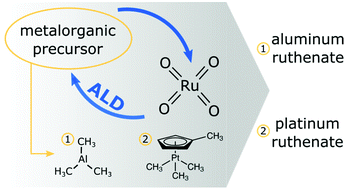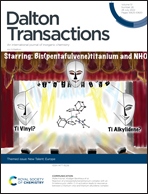Atomic layer deposition of ternary ruthenates by combining metalorganic precursors with RuO4 as the co-reactant†
Abstract
In this work, the use of ruthenium tetroxide (RuO4) as a co-reactant for atomic layer deposition (ALD) is reported. The role of RuO4 as a co-reactant is twofold: it acts both as an oxidizing agent and as a Ru source. It is demonstrated that ALD of a ternary Ru-containing metal oxide (i.e. a metal ruthenate) can be achieved by combining a metalorganic precursor with RuO4 in a two-step process. RuO4 is proposed to combust the organic ligands of the adsorbed precursor molecules while also binding RuO2 to the surface. As a proof of concept two metal ruthenate processes are developed: one for aluminum ruthenate, by combining trimethylaluminum (TMA) with RuO4; and one for platinum ruthenate, by combining MeCpPtMe3 with RuO4. Both processes exhibit self-limiting surface reactions and linear growth as a function of the number of ALD cycles. The observed saturated growth rates are relatively high compared to what is usually the case for ALD. At 100 °C sample temperature, growth rates of 0.86 nm per cycle and 0.52 nm per cycle are observed for the aluminum and platinum ruthenate processes, respectively. The TMA/RuO4 process results in a 1 : 1 Al to Ru ratio, while the MeCpPtMe3/RuO4 process yields a highly Ru-rich composition with respect to Pt. Carbon, hydrogen and fluorine impurities are present in the thin films with different relative amounts for the two investigated processes. For both processes, the as-deposited films are amorphous.

- This article is part of the themed collection: New Talent: Europe


 Please wait while we load your content...
Please wait while we load your content...